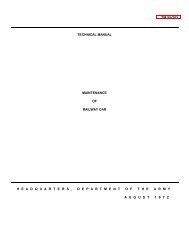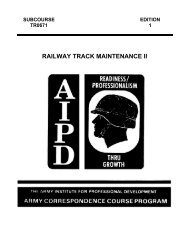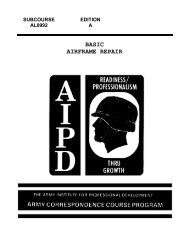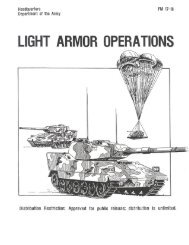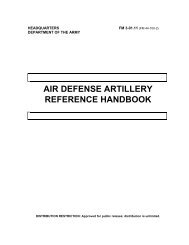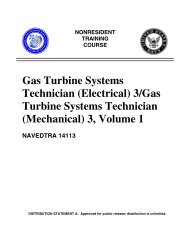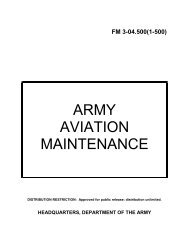fm 44-100 us army air and missile defense operations
fm 44-100 us army air and missile defense operations
fm 44-100 us army air and missile defense operations
Create successful ePaper yourself
Turn your PDF publications into a flip-book with our unique Google optimized e-Paper software.
FM <strong>44</strong>-<strong>100</strong><br />
4-24<br />
4-124. Threat. The probability of an asset or force being targeted for<br />
surveillance or attack by enemy <strong>air</strong> m<strong>us</strong>t be assessed as part of the threat.<br />
The <strong>us</strong>e of threat information to develop AD priorities is a reverse IPB<br />
process--what we expect enemy <strong>air</strong> to survey <strong>and</strong> attack, based on IPB.<br />
Targeting information provided by intelligence estimates, past enemy<br />
surveillance <strong>and</strong> attack methods, <strong>and</strong> threat doctrine is <strong>us</strong>eful in evaluating<br />
<strong>air</strong> <strong>and</strong> <strong>missile</strong> <strong>defense</strong> priorities. To determine the relative importance of<br />
assets <strong>and</strong> forces, the ADA comm<strong>and</strong>er considers certain characteristics that<br />
make an asset or force a lucrative target for the enemy. In effect, this is<br />
reverse target value analysis.<br />
STAGE SIX -- POSTCONFLICT OR POSTCRISIS OPERATIONS<br />
4-125. Deployed forces transition to a period of post-conflict <strong>operations</strong> after<br />
hostility has ceased or a truce is declared. This transition can occur in one<br />
part of a theater while combat <strong>operations</strong> are still underway in other parts.<br />
Post-conflict <strong>operations</strong> foc<strong>us</strong> on restoring order, minimizing conf<strong>us</strong>ion<br />
following the operation, reestablishing host nation infrastructure, preparing<br />
forces for redeployment, <strong>and</strong> continuing a presence to allow other elements of<br />
national power to achieve the overall strategic aims. Post-conflict <strong>operations</strong><br />
place dem<strong>and</strong>s on every level of comm<strong>and</strong>. ADA units may be called upon to<br />
conduct humanitarian assistance <strong>and</strong> population control. ADA personnel may<br />
be required to control prisoners, h<strong>and</strong>le refugees, <strong>and</strong> perform other related<br />
humanitarian assistance <strong>and</strong> control activities.<br />
4-126. However, the post-conflict stage may be interrupted by the resumption<br />
of hostilities. Th<strong>us</strong>, units m<strong>us</strong>t rapidly consolidate, reconstitute, train, <strong>and</strong><br />
prepare to remain in theater should the fighting resume. During this time,<br />
force protection is vital to prevent isolated attacks. ADA forces concentrate on<br />
providing force security <strong>and</strong> preventing surprise, permitting unimpeded<br />
reconstitution <strong>and</strong> facilitating unopposed embarkation of forces that are no<br />
longer needed in theater. Air <strong>and</strong> <strong>missile</strong> <strong>defense</strong> forces may remain in<br />
theater after the end of hostilities to perform stability <strong>and</strong> support<br />
<strong>operations</strong>.<br />
STAGE SEVEN -- REDEPLOYMENT<br />
4-127. The objective of this stage is to return to home station the forces that<br />
are no longer needed. Post-conflict requirements have a direct effect on the<br />
redeployment flow. Comm<strong>and</strong>ers contend with the same challenge as in<br />
deployment, which is balancing the factors of METT-TC against available lift<br />
assets. Forces not required for subsequent <strong>operations</strong> will return to home<br />
station <strong>and</strong> prepare for future missions.<br />
4-128. Protection of the force during redeployment is as critical as during<br />
deployment or any other stage of the operation. While the most significant<br />
aerial attack capabilities may have been eliminated, <strong>air</strong> <strong>and</strong> <strong>missile</strong> <strong>defense</strong><br />
forces m<strong>us</strong>t be prepared to counter desperation or retaliatory <strong>air</strong> <strong>and</strong> <strong>missile</strong><br />
attacks.<br />
4-129. Reconstitution activities can begin in theater prior to redeployment.<br />
They include rebuilding unit integrity <strong>and</strong> accounting for soldiers <strong>and</strong><br />
equipment. If the force has been exposed to nuclear, chemical, or biological




